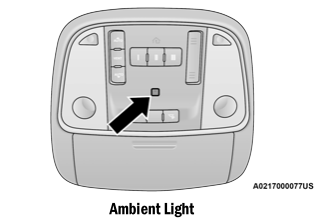Dodge Charger: UNIVERSAL GARAGE DOOR OPENER (HOMELINK®) / Before You Begin Programming HomeLink®, Erasing All The HomeLink® Channels
Before You Begin Programming HomeLink®
For efficient programming and accurate transmission of the radio-frequency signal, it is recommended that a new battery be placed in the hand-held transmitter of the device that is being programmed to the HomeLink® system. Make sure your hand-held transmitter is programmed to activate the device you are trying to program your HomeLink® button to.
Ensure that your vehicle is parked outside of the garage before you begin programming.
It is recommended that you erase all the channels of your HomeLink® before you use it for the first time.
Erasing All The HomeLink® Channels
To erase the channels, follow this procedure:
- Place the ignition switch into the ON/RUN position.
- Push and hold the two outside HomeLink® buttons (I and III) for up to 20 seconds, or until the HomeLink® indicator light flashes.
NOTE:
Erasing all channels should only be performed when programming HomeLink® for the first time. Do not erase channels when programming additional buttons.
 UNIVERSAL GARAGE DOOR OPENER (HOMELINK®)
UNIVERSAL GARAGE DOOR OPENER (HOMELINK®)
HomeLink® replaces up to three hand-held transmitters that operate devices
such as garage door openers, motorized gates, lighting, or home security systems...
 Identifying Whether You Have A Rolling Code Or Non-Rolling Code Device
Identifying Whether You Have A Rolling Code Or Non-Rolling Code Device
Before programming a device to one of your HomeLink® buttons, you must determine
whether the device has a rolling code or non-rolling code.
Rolling Code Devices
To determine if your device has a rolling code, a good indicator is its manufacturing
date...
Other information:
Dodge Charger 2011-2025 Owner's Manual: Driver And Passenger Front Air Bag Features
The Advanced Front Air Bag system has multistage driver and front passenger air bags. This system provides output appropriate to the severity and type of collision as determined by the Occupant Restraint Controller (ORC), which may receive information from the front impact sensors (if equipped) or other system components...
Dodge Charger 2011-2025 Owner's Manual: Default Mode
The vehicle will always start in Default Mode. This mode is for typical driving conditions. While in Default Mode, the Engine/Transmission, and Traction will operate in their Normal settings and cannot be changed. The Steering Assist may be configured to “Normal”, “Sport”, or “Comfort” by pressing the corresponding button on the touchscreen...
Categories
- Manuals Home
- Dodge Charger Owners Manual
- Dodge Charger Service Manual
- WHEEL AND TIRE TORQUE SPECIFICATIONS
- To Disarm The System
- Dimmer Controls
- New on site
- Most important about car
Ambient Light — If Equipped
The overhead console is equipped with an ambient light feature. This light illuminates for improved visibility of the floor and center console area.

